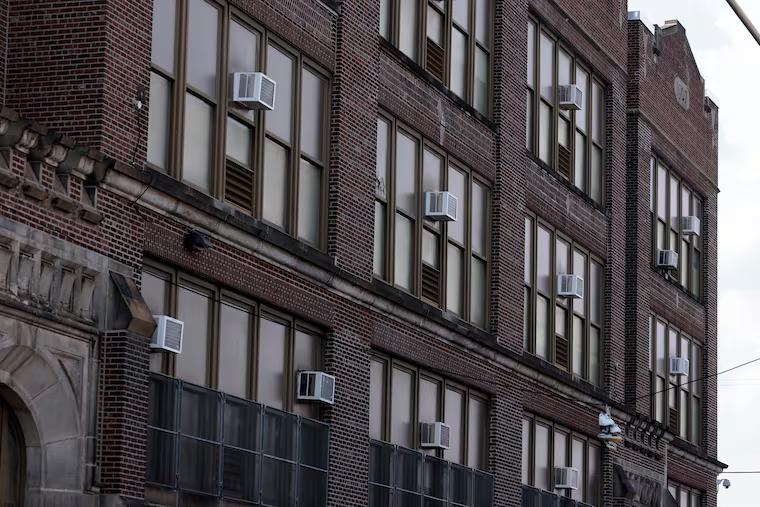Even in many air-conditioned Philly classrooms, it’s sweltering: How did it get this way?
“Temperatures in our ‘air-conditioned’ classrooms are in the 80s,” one teacher said. “I have no idea how my students and I will survive this week.”

Alan Foo gulped Gatorade for breakfast on Thursday in preparation for his sweltering job: teaching fifth graders at Bayard Taylor Elementary School, where he grew so dehydrated and groggy this week he had to seek medical attention.
Taylor, built in 1907, has air-conditioning in most, though not all classrooms, but the school’s hallways and common spaces lack climate control, and basement rooms — which includes spaces where preschool and special-education students learn — have no air-conditioning at all. And the 1907 building relies on window units, many of which struggle to cool classrooms with 20-plus students and staff.
“Temperatures in our ‘air-conditioned’ classrooms are in the 80s,” said Foo, who’s taught at Taylor for 17 years. “I have no idea how my students and I will survive this week.”
Though the Philadelphia School District called early dismissals through Friday for 86 schools that lack air-conditioning or have inadequate or nonfunctional cooling systems, conditions inside many “climate-controlled” schools — like Taylor, on North Randolph Street in Philadelphia’s Hunting Park section — were often still unbearable.
For State Sen. Vincent Hughes (D., Phila.), the situation is the continuing evidence of decades of underfunding. (A Commonwealth Court judge ruled this year that the way Pennsylvania has funded schools for decades is unconstitutional and deprives low-wealth districts like Philadelphia of resources to adequately educate students. The state’s Basic Education Funding Commission meets next week to hear testimony on how to fix it.)
“You could go down to the Philadelphia Art Museum right now and not get a picture more clear than what’s being presented here,” Hughes said. “If these schools were funded properly over generations, we wouldn’t be here — you don’t see this problem in Lower Merion, ... in Upper Dublin.”
Superintendent Tony B. Watlington Sr. said on Tuesday, the first day of classes for 113,000 district students, that when he came to Philadelphia in 2022, he was surprised to find that the district was still coping with closures during soaring temperatures. The Southern school systems he worked in for years eliminated those problems 20 years ago.
“And those weren’t Rockefeller-rich school districts,” Watlington said. “I think this is one of the vestiges of historical underfunding.”
Overheated students, malfunctioning cooling systems
Colleen Sperber teaches fifth graders in a nominally air-conditioned third-floor classroom at Webster Elementary in Kensington. The heat there this week left her wringing sweat out of her ponytail.
Sperber, a 12-year veteran, wants to start the school year off strong, but she doesn’t think much learning is going on.
“I feel like we’re just getting through the day, surviving in there because it’s so gross,” Sperber said. “I can’t expect them to give me their full attention when they’re having to fan themselves, falling asleep at their desks, and telling me they didn’t feel good.”
There are 30 students in her class, eight of whom have asthma. Sperber worries about their health in the heat.
At Philadelphia High School for Girls, the air-conditioning malfunctioned on Thursday, according to multiple people with firsthand knowledge of the situation. Temperatures inside the school cafeteria were in the 90s; some staff and students became ill.
Staff let district officials know of the hot conditions, but were told they had to remain in the building.
“Blazing hot,” was one 12th grader’s description. “Even with air in some of the classrooms, it is still hot sitting right in front of the air, yet we are still in here for a full day.”
Erik Fleming spent all week fielding phone calls from frustrated, overheated staff inside Philadelphia schools. Fleming, a staffer with the Philadelphia Federation of Teachers, has heard about air-conditioners that aren’t blowing cold air, staff and students sickened, and one teacher “who told me her room is so hot that she’s resorting to going into the hallway because it’s slightly cooler.” (The teacher’s room has air-conditioning, but it’s not working; the hallway is not air-conditioned.)
And it’s not just the district’s old buildings — though the average school age is over 70 years old.
“We have locations with brand-new systems that are not working,” Fleming said.
Communities ‘paying the price’
Jerry Jordan gets it. In a system that routinely encounters financial crises and lacks the ability to raise its own revenue, “there’s just often not enough money left to deal with maintenance,” said Jordan, PFT president. “It’s been let go for so long, this has not been a priority, and now we’re paying the price.”
The heat wave has some school communities banding together to fundraise or purchase air-conditioning units. But Monique Braxton, district spokesperson, urged them to hold off.
“We value working with our families as partners in their children’s education and appreciate their desire to support healthy and comfortable learning environments,” Braxton said, but solving the problem for hot schools “is not as simple as adding individual window units to classrooms.”
In many schools, the electrical systems cannot support enough window units to adequately cool schools
“We’re encouraging our school communities to refrain from purchasing air-conditioners while we work expediently to assess all electrical systems across the district,” Braxton said in a statement.
Officials said all district schools won’t be air-conditioned until 2027.